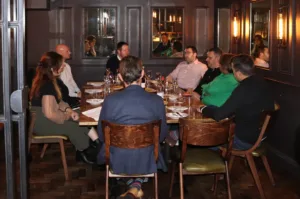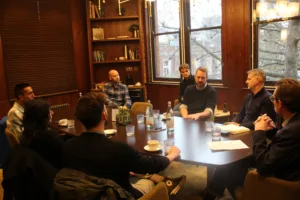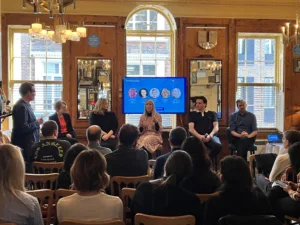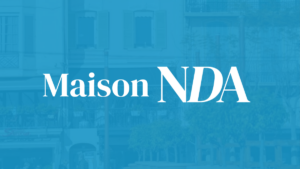Interest in native advertising is on the rise – but why now and how has native evolved for the modern marketer? New Digital Age (NDA) in association with Adyoulike, recently hosted a roundtable discussion of industry experts to explore what native advertising means today, and how advertisers and their agencies are leveraging native in 2022.
NDA’s managing editor Justin Pearse chaired the session, where he was joined by Kevin Sewell, commercial director at Adyoulike; Clare Ritchie, Global Head of Programmatic, MediaCom; Ross Coombes, Programmatic Commercial Director, Mindshare UK; Eloise Purnell, Biddable Associate Director, Performics @Starcom; Charlie Ashe, Head of Client Data and Strategy, tmwi; and Amir Malik, Managing Director & Growth Marketing Practice Founder at Accenture.
Native advertising, i.e. sponsored content that attempts to mimic the format and function of the media brand it appears on, is not a new idea, with roots that reach back to the early days of news publishing. Once more commonly referred to as ‘advertorial’, the basic idea behind native advertising is to provide readers with a less disruptive experience than conventional advertising and create opportunities to engage and educate ad-resistant readers with longer form content.
The native way
Ritchie opened up the discussion by suggesting one of the reasons that native is back in vogue is that it sets a principle for how marketers should behave and buy media generally. She said: “Ultimately, we should be focusing on engaging with our consumers in non-disruptive ways via the media of their choice. Clients often have a lot of demands about the media they advertise in, for example, from a brand safety perspective. What’s less common is for advertisers to consider the actual form of those media and how their planned campaign is likely to come across to a particular media outtlet’s user base. The more we normalise ‘native’ and the principles behind it, the better media planning we’ll be doing on the whole.”
Ashe made the point that, in terms of social activity, marketers had already grasped the need to tailor their content to each individual social platform but, for some reason, that native approach was still not being applied across their wider media spending.
He said: “If you understand the user journeys that your customers are making in order to purchase from your brand, you can identify any challenges they may encounter along the way. Native advertising provides an opportunity to address those challenges and engage those customers in a way that display advertising can’t replicate. Another advantage of native is that, where the brand’s story is more complex, it lets you communicate a number of brand messages in a single hit.”
Purnell picked up on this latter point, adding: “Generally speaking, content blindness continues to be a problem in display. For example, one of my main clients, a large for-profit subscription business, is a very complicated business to try to explain in a display ad. As a result, I’m sure you’re aware of the brand, but you probably don’t know exactly what it is or how it works or why. For brands like that, native is uniquely placed to fill the gap from an education perspective.”
Native uprising
Malik was emphatic in his support for native as a format. He said: “In the history of digital advertising, no format has had more of an impact or engagement score than native ads. If you look at how it performs against standard digital display formats, native has way more effective metric-based engagement stats and is also better at building brand equity. In terms of emerging opportunities for native, I think the convergence of influencer marketing and native advertising could be an exciting area for brands over the next couple of years.”
Ritchie added that with emerging channels like digital audio and CTV beginning to capture a larger share of media budgets, there’s an interesting opportunity right now to explore what native advertising looks like in those spaces.
From an agency perspective, said Coombes, native advertising requires a balancing act between the needs of the client and the needs of the publisher: “When you’re taking creative direction from the brand, the publisher’s perspective can sometimes get overlooked. That’s a real danger because, for me, when native advertising goes wrong, it looks a lot worse than a poorly targeted display or video ad. If your content doesn’t fit the publisher or the publisher doesn’t fit your brand’s image, the lasting impression on the reader is a negative one.”
Given the likely impact of third-party cookie deprecation on publisher ad revenues, Sewell of Adyoulike believes that native advertising could be a key tool in delivering value for brands, publishers and readers alike. He said: “As a native SSP, until recently, there has been a natural inclination for us to concentrate on reaching large consumer audiences and bigger publications for our clients. The way the market is evolving and something we’re considering at AdYouLike is how can native advertising now be leveraged to support quality journalism from the smaller publications? How can we help our clients work with a wider, more diverse and inclusive pool of quality publishers at scale on the open ‘non-addressable’ web?
“I don’t think there’s any naivete about native advertising in modern consumers. Most people are quite switched on about what is paid for and what’s not. Regular readers of a particular site are aware of the value exchange that’s going on, i.e. that being ‘marketed to’ is in exchange for the free content they enjoy. We’re expanding across Europe fairly rapidly at the moment, so we’re excited about the future of native. Interest in the channel is growing thanks to the format’s capabilities as an omnichannel and contextual campaign tool in the post-cookie era. In the end, native is essentially about engaging target audiences in the most natural way possible: by providing them with great content at a time when they are ready to consume it.”









